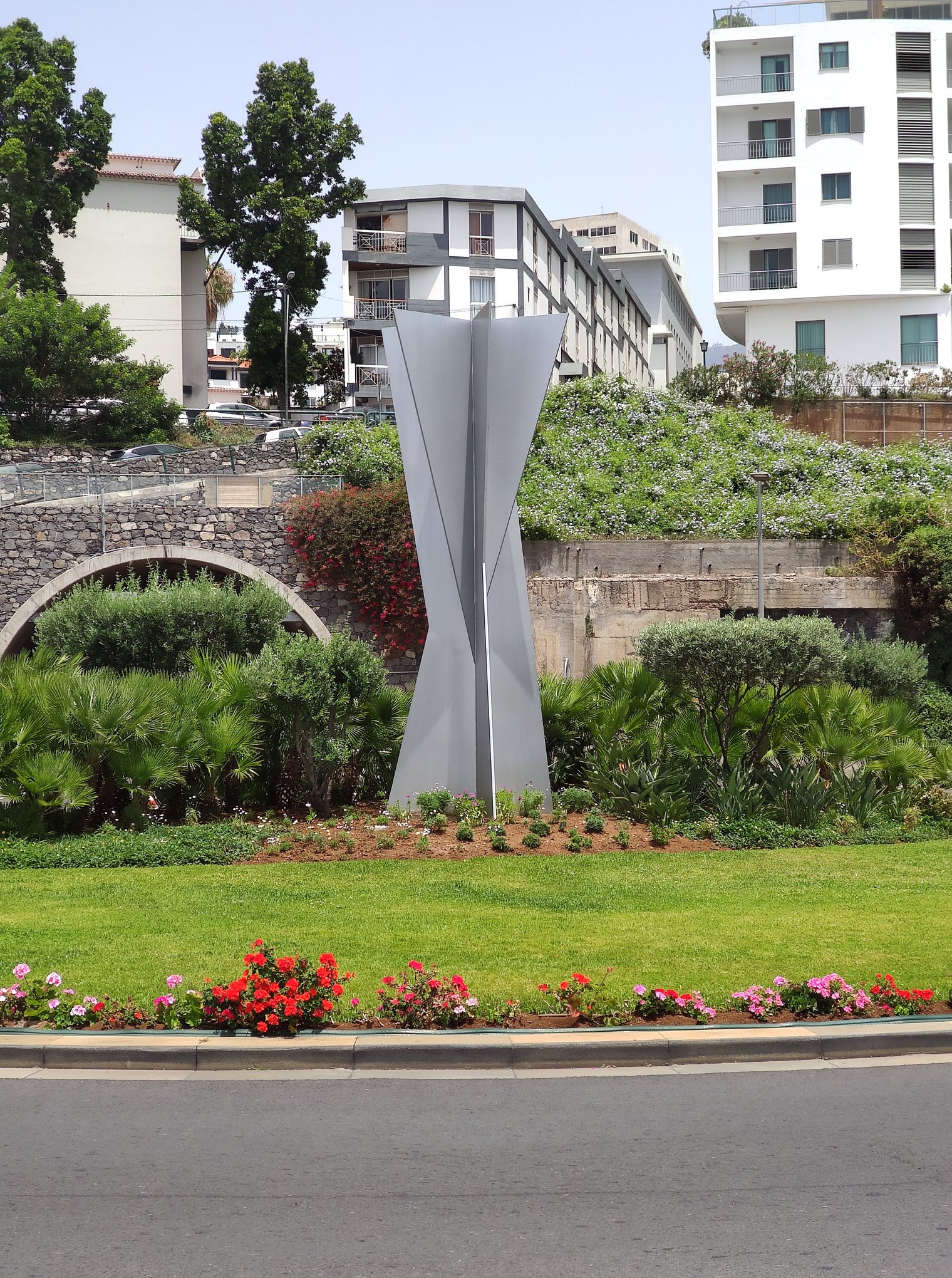It was inaugurated on July 1, Day of the “Região Autónoma da Madeira” and Madeiran Communities, in the present year of 2020. Its author is the Madeiran sculptor Amândio de Sousa (Funchal, 1934).
It is a piece made of painted steel. It measures 6 meters high by 2.40 meters in diameter and weighs 5.8 tons. The project was coordinated by the company “Massa Cinzenta” (architect Duarte Caldeira). It is located at the “Rotunda Bernard Harvey Foster” (Funchal). It is an order for the “Commemoration of the 600 Years of the Discovery of the Madeira Archipelago” within the program of the XIII Government of the “Região Autónoma da Madeira”, which explains the defense of creativity, research, entrepreneurship, promotion and dissemination (…) [and] the creative potential and its cultural heritage”.
The request to the sculptor Amândio de Sousa is a public acknowledgment of the artist and his work. The sculptor Amândio de Sousa is an unavoidable personality and a master figure in the field of plastic arts, especially in the area of contemporary sculpture (in round shape or relief; medal and trophy; design and furniture), having explored various materials (clay, sandstone), plaster, stone, fiberglass and concrete). In the «Commemorative Sculpture of the 600 Years of the Discovery of the Madeira Archipelago» it is attested that the sculptor valued formal depuration, conveying a decorative stripping and enhancing the geometric rigor, with games of orthogonalities and obliquities, and intersecting plans that provide different readings, depending on the position of the observer, requiring an exercise of the gaze: to see, to observe, to feel, to understand. To read / interpret this sculptural piece is to go beyond form, volume and color. It is entering the play. Understand it and feel it: discover its symbolisms and metaphors. This piece, or “Metal Tree”, is underlined by its verticality, strongly implanted in the soil (red earth), which grows and branches (opens to the world), allowing an interpretation of expansion, so symbolic in character to the travels of the Portuguese, the arrival to the archipelago of Madeira and the beginning of its settlement. This “Metallic Tree” allows one to look at the sea, from where the men who knew nothing about the wide sea, because they sailed along the coasts, they feared that blackness a lot, they moved away from this route and fabled great things about this darkness (...) but they went coasting the island along the grove, which in parts arrived at the sea (…) ”(Jerónimo Dias Leite, c.1579).
This sculpture is an allusion to the epic Portuguese, of the adventures in search of an unknown world, which implied knowledge, but also fear, adventure, determination, suffering, and dream, having then the Madeira Archipelago of great importance in the Atlantic expansion, and the Funchal harbor is a reference to opening up to the world: here men and women of so many nationalities arrived and left, and, fortunately, there was so much memory in the form of Cultural Heritage.
The present work of the sculptor Amândio de Sousa refers to a commemorative sculpture, which for its plastic and symbolic quality, will endure in the scenery of this Atlantic capital evoking the epic of the Discoveries and the importance that the archipelago represented in that historical time and what it represents even today in the valorization of this touristic destination from the point of view of its cultural dimension, contributing to a new feeling of those who are born here, live, work and after many times leave, return or are just passing through. It is a sculpture-memory of the past, always envisaging a place in the collective imagination.
Amândio de Sousa graduated from the “Escola das Belas Artes do Porto” and his teachers were two great figures of Portuguese sculpture: Barata Feyo (1899-1990) and Lagoa Henriques (1923-2009). He related to artists who marked the Portuguese artistic avant-garde, from the 1960s, of the 20th century, such as the painters Ângelo de Sousa (1938-2011), Armando Alves (1935-), Jorge Pinheiro (1931-) and the sculptor José Rodrigues (1936-2016). In Madeira, he performed functions related to culture, as Advisor for Cultural Affairs (1976-1978), having prepared the «Basic Guide to Cultural Action», in partnership with Carlos Lélis (1931-), then Regional Secretary for Education and Culture. He was director of the “Quinta das Cruzes” Museum (1977-2001). He is the author of articles published in magazines and organized events relevant to culture (colloquia and exhibitions). He worked in artistic partnerships with architects Rui Goes Ferreira (1926-1978); Chorão Ramalho (1914-2002); Marcelo Costa (1927-1994).
Among his numerous public works, the following stand out: «Commemorative Sculpture of the 1st Football Game in Madeira», Camacha, 1969; «Trilogy of Powers», Legislative Assembly of Madeira, 1990; «Commemorative Sculpture of the 500 Years of the Foundation of the Council of Ponta do Sol», 2001.
Text: Rita Rodrigues





